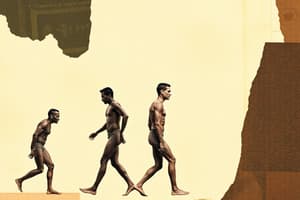Podcast
Questions and Answers
What type of food supply did people have in the Neolithic Age?
What type of food supply did people have in the Neolithic Age?
- Unstable
- Limited
- Nomadic
- Stable (correct)
What jobs did people have in the Paleolithic Age?
What jobs did people have in the Paleolithic Age?
- Hunting (correct)
- Crafting
- Gathering (correct)
- Farming
What type of housing did people have in the Neolithic Age?
What type of housing did people have in the Neolithic Age?
- Temporary
- No housing
- Mobile
- Permanent (correct)
In the Paleolithic Age, people cared about trade and resources.
In the Paleolithic Age, people cared about trade and resources.
They both had a way to get food and water, had houses, satisfied their needs, had jobs, both in the ___ Age.
They both had a way to get food and water, had houses, satisfied their needs, had jobs, both in the ___ Age.
What marked the beginning of change in the Neolithic Age?
What marked the beginning of change in the Neolithic Age?
What were the earliest forms of agriculture?
What were the earliest forms of agriculture?
What does the term 'domesticate' refer to?
What does the term 'domesticate' refer to?
What was Jericho known for?
What was Jericho known for?
What animal was NOT one of the first tamed?
What animal was NOT one of the first tamed?
The period in ancient human culture when people began to make and use ___ is called the Bronze Age.
The period in ancient human culture when people began to make and use ___ is called the Bronze Age.
Where did farming first begin?
Where did farming first begin?
What was one of the benefits of settled life?
What was one of the benefits of settled life?
Flashcards are hidden until you start studying
Study Notes
Food Supply
- Neolithic people established stable food supplies through farming.
- Paleolithic people relied on unstable food sources as hunter-gatherers.
Jobs
- A variety of jobs emerged in the Neolithic age due to settled life.
- Paleolithic societies had limited roles focused solely on hunting and gathering.
Homes
- Neolithic communities built permanent homes and formed villages.
- Paleolithic groups utilized temporary shelters, moving frequently in search of food.
Trade and Resources
- Trade became significant in the Neolithic period, reflecting an organized economy.
- Paleolithic societies had minimal focus on trade or resource management.
Similarities
- Both periods involved strategies for securing food and water and fulfilling basic needs.
- Both cultures belonged to the Stone Age and consisted of human societies.
Paleolithic
- Considered the earliest part of the Stone Age, characterized by hunting and gathering.
Neolithic
- Marked a transformative period in human history, lasting around 4000 years; means "New Stone."
Nomads
- Nomadic groups regularly migrated for survival, following food sources.
Technology
- Paleolithic people used basic tools and methods for daily tasks.
Ice Ages
- Extended periods of extreme cold that influenced global ecosystems and human migrations.
Systematic Agriculture
- Involves organized food production on a regular schedule, beginning in the Neolithic period.
Domesticate
- The process of adapting animals to live with humans for mutual benefit.
Shrines
- Places of worship decorated with images of deities, often featuring statues symbolizing fertility.
Specialization
- Development of specific skills for particular occupations in Neolithic societies.
Bronze Age
- A later period where the use of bronze became prevalent for tools and weapons.
Monarchy
- Early governance model where power was inherited, establishing armies and law-making.
After the Ice Age
- Warmer temperatures led to settlements in fertile areas, with a transition from hunting to farming.
Real Change from Paleolithic to Neolithic Age
- Transition from hunting and gathering to systematic agriculture fundamentally altered lifestyles.
Agricultural Revolution
- Refers to significant advancements in farming techniques and settled life, considered pivotal in human history.
Southwest Asia
- The region where the first farming activities began.
First Farmed Crops
- Barley and wheat were among the earliest cultivated plants.
First Tamed Animals
- Swine, cattle, goats, and sheep were among the first domesticated species.
Farming Spread
- Farming practices extended to Southeastern Europe from Southwest Asia.
Central Africa
- Cultivation of root crops such as yams and fruit trees, including bananas.
China
- Millet became a staple food crop, alongside domesticated dogs and pigs.
Southeast Asia
- Rice emerged as an essential agricultural product.
Mexico and Central America
- Corn, squash, potatoes, and domesticated chickens and dogs were significant crops.
Major Communities
- The largest early communities were found in Southwest Asia.
Jericho
- Recognized as the oldest known community.
Catalhuyuk
- Featured roofs with accessible doors and shrines, supporting both farming and hunting lifestyles.
Religion
- The emergence of shrines and statues highlighted the growing importance of spirituality in Neolithic life.
Benefits of Settled Life
- Settled communities offered security, a steady food supply, and population growth, enabling trade and agricultural advancements.
Studying That Suits You
Use AI to generate personalized quizzes and flashcards to suit your learning preferences.




